
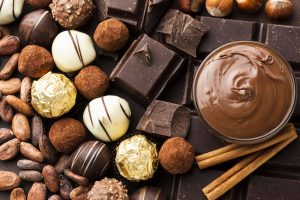 In this Tiny Expedition, we ask a scary question that keeps popping up in the news every few years: will we see a chocolate shortage in our lifetime? The short answer: not if science can help it.
In this Tiny Expedition, we ask a scary question that keeps popping up in the news every few years: will we see a chocolate shortage in our lifetime? The short answer: not if science can help it.
Chocolate is an indulgence, a treat, and the main ingredient in some of our favorite comfort foods. It comes in many varieties ranging from white chocolate to milk chocolate to dark chocolate. It even pairs well with many other flavors, one of the most popular being peanuts.
The chocolate that we all know and love is made from the fruits of the cacao tree, which only grow in a slim band of tropical rainforests 18 degrees north and south of the equator. Rising temperatures from climate change threaten to destroy the only environment in which these trees thrive. Cacao trees also have many foes that can interfere with a successful harvest like pests, fungal infections, and other diseases.
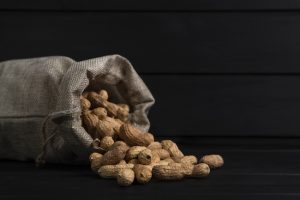
Chocolate’s most common partner in crime, the peanut, is also under siege by weather events like drought, heavy periods or rain or late freezes, and both pests and disease. One peanut foe called aflatoxins are especially dangerous to humans.
Listen to Tiny Expeditions Season 2, Episode 2: “Can science save your favorite candy bar?” to journey into the world of chocolate and peanuts and learn how scientists are trying to save our favorite candy bars by protecting the plants that produce the tasty ingredients that make up these sweet treats.
Behind the Scenes
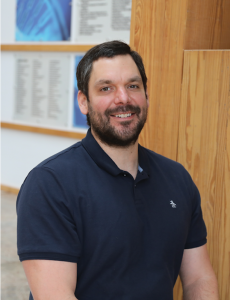
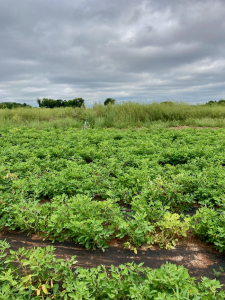
Josh Clevenger, PhD (left), is HudsonAlpha’s resident peanut expert. Dr. Clevenger is interested in crop improvement for sustainable agriculture. He and his lab work to improve computational technologies and breeding methods to benefit not only their peanut genomics work, but also crop genomics as a whole.
Our walk to the peanut field was almost like journeying to Narnia. One second we were walking down the Double Helix on HudsonAlpha’s campus and the next second we stepped through some bushes into an open field with rows and rows of peanuts. The photo on the bottom left shows the peanut field. Dr. Clevenger told us that there were over 1,000 peanut plants in the field, each one planted by hand by his team. 1,000 peanut plants means 1,000 holes had to be dug in the red Alabama clay with a post hole digger. This sounds like a whole lot of laborious work, but for Dr. Clevenger it is a labor of love.
The peanuts that we were looking at are very special to Dr. Clevenger and his team. They are a population of peanuts to test molecular markers the group developed to select for aflatoxin mitigation. They crossed Carolina Black peanuts with ICG1471, a senegalese line that is drought tolerant and has aflatoxin resistance. The Carolina Black peanuts have a deep purple skin that is full of polyphenols that are important for health purposes but might also confer aflatoxin resistance.
According to Dr. Clevenger, the peanuts are doing well and will be harvested soon. The photo on the bottom right shows pegs growing from the peanut plant to the soil. The peg forms after fertilization and is how the fertilized egg (a future peanut) makes it way from the above-ground parent into the soil to mature.
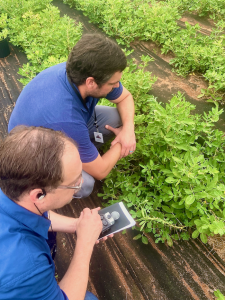
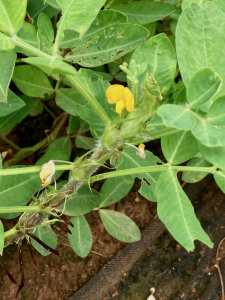
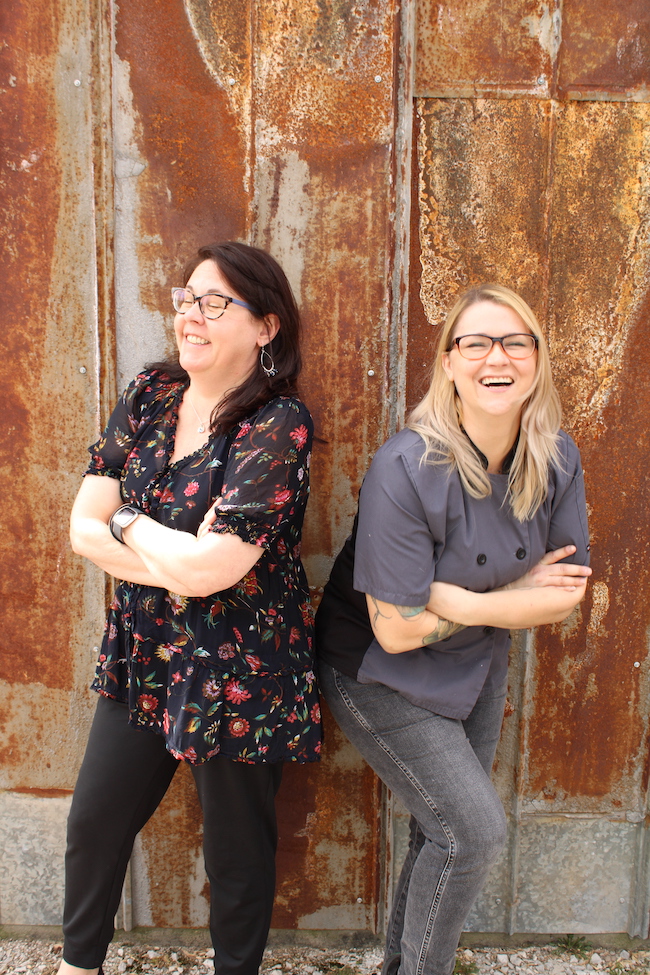
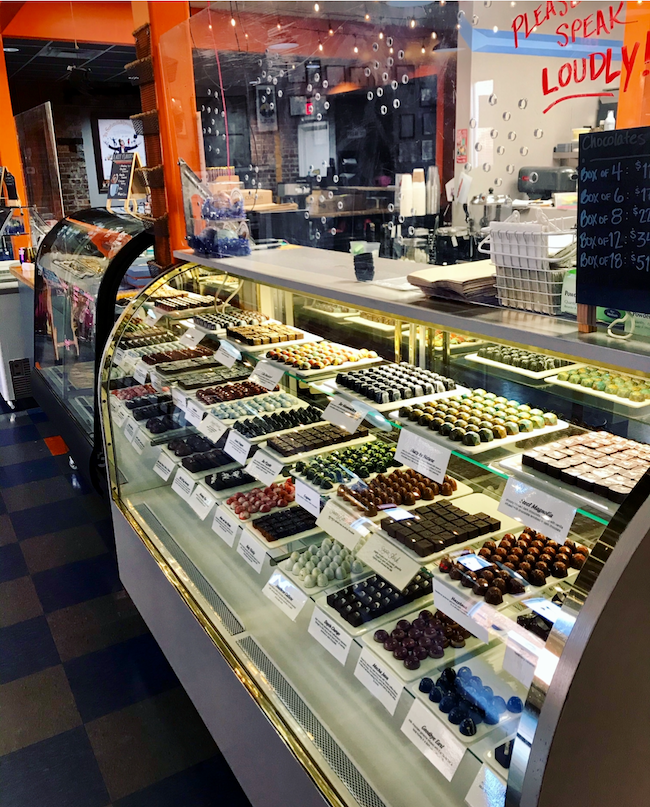
Pizzelle’s Confections is located in an old railroad room at the Lowe Mill Arts and Entertainment. Described on their website as “an eclectic mix of edible art and culinary exploration”, Pizzelle’s more than delivered. The shop itself is a funky, artistic mix of leftover graffiti from its time as a railroad room, movie posters, local art, and many nods to the chocolate man himself, Willie Wonka. Oh, and did we mention there is a velociraptor head?
Pizzelles’ co-owners and sisters Michelle Novosel and Caitlin Lyon (pictured top left) are self-proclaimed chocolate witches. Each sister has her own role at the shop. Michelle is the Executive Chocolatier & Pastry Chef while Caitlin serves as the General Manager. When the store opened in 2013, the sisters still believed it would be a fun little hobby. But that hobby pretty quickly turned into the lucrative business it is today.
As you probably heard from the interview clips, we had an amazing time chatting with Caitlin and Michelle. Their love for chocolate and their appreciation for their staff was so refreshing.
The chocolates, mini cakes, and macarons are each individual works of art. There was no way that we were going to tour a chocolate shop without indulging in some ourselves. The photos to the right show some of the chocolates that we tried. These pieces of chocolate art are just as delicious as they are beautiful.
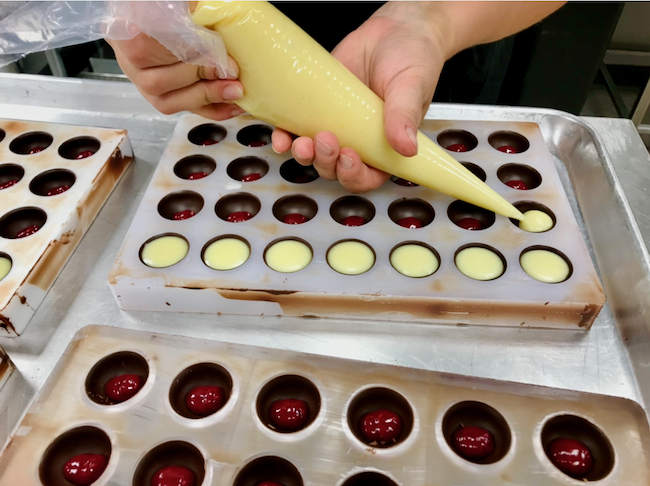
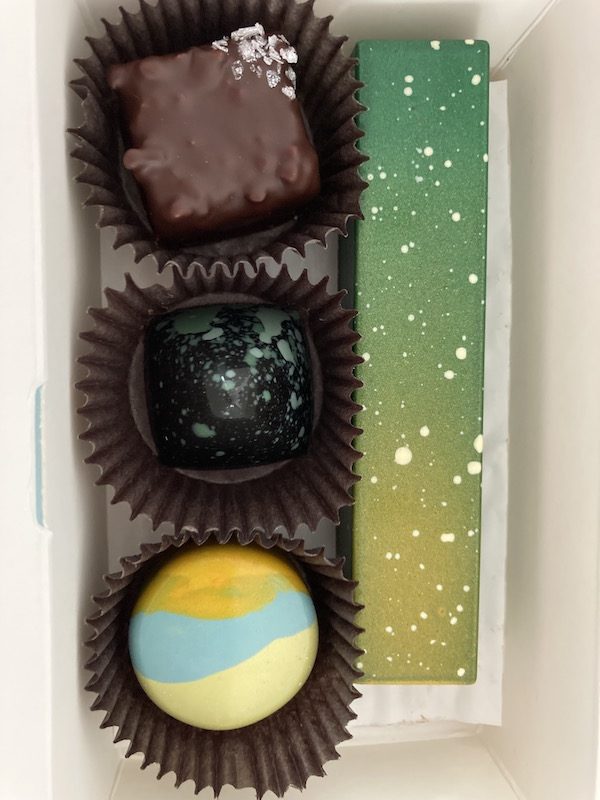
Chris Powell 00:00
Welcome to episode two of season two of Tiny Expeditions. And as we get into today’s episode on chocolate and peanuts, we want to give you a word of warning. We use binaural audio in the recording of certain segments of today’s episode. So just be aware of this especially if you’re driving a car and be safe because it may sound like things are coming from behind you or around you. We hope you enjoy today’s episode.
Sarah Sharman 00:33
Chocolate- it is there for us in the good times and the bad. From Valentine’s Day gifts to trick or treats on Halloween to drowning our sorrows after a breakup.
Chris Powell 00:44
So what’s your favorite candy bar?
Person on the street 00:48
I think my favorite candy bar these days is just plain good quality chocolate.
Person on the street 00:53
My favorite candy bar is Snickers.
Chris Powell 00:55
Snickers, so what about Snickers do you like?
Person on the street 00:57
The chocolate and the nuts, they go great together.
Chris Powell 01:01
So, what would you say is your favorite candy bar or chocolate bar?
Person on the street 01:06
Twix.
Person on the street 01:07
Snickers with almonds.
Chris Powell 01:10
Oh, Snickers with almonds throwing a twist in.
Person on the street 01:12
Reese’s Peanut Butter Cup.
Chris Powell 01:14
So, what’s your favorite candy bar?
Person on the street 01:17
Almond Joy.
Chris Powell 01:18
Almond Joy. What about Almond Joys do you like?
Person on the street 01:21
Oh, I like coconut. And I like almonds. And I like milk chocolate.
Person on the street 01:25
Let’s see Snickers. No wait- Almond Joy, or maybe Mounds because I like the dark chocolate.
Chris Powell 01:33
My name is Chris. I’ll be your storytelling guide for this episode. And I’m also a Reese’s Peanut Butter Cup lover.
Sarah Sharman 01:38
And I’m Sarah, your science advisor for this episode. And I’m more of a dark chocolate gal.
Chris Powell 01:46
We all love chocolate. Put that chocolate together with a peanut and magical things can happen.
Sarah Sharman 01:53
But why is there something science can tell us?
Chris Powell 01:56
While chocolate tastes magical. The process of making chocolate is actually straightforward. But it’s a process that many of us haven’t stopped to think about. I mean, where does your chocolate come from?
Sarah Sharman 02:08
Chocolate is made from the fruits of the cacao tree with roots dating back 5000 years to ancient civilizations in Central and South America.
Chris Powell 02:17
So if you want to have chocolate, you need cacao trees. And these cacao trees live in a very small geographical regions of the world. They’re grown mostly by small time farmers and the trees themselves are facing numerous threats from disease to pests to climate change.
Sarah Sharman 02:35
But before we get to those threats, we want to introduce you to Dr. Josh Clevenger, who is using science to save our favorite chocolate and peanut treats.
Josh Clevenger 02:44
My name is Josh Clevenger, faculty investigator at HudsonAlpha Institute for Biotechnology. My lab translates genomics into practical outcomes. So, we use genomics to improve the genetics of plants for growers and producers all over the world. After I got an undergraduate degree, I worked at Ohio State working on tomatoes. And after that I went and did a PhD on peanuts and did a short postdoc on peanuts and then worked as a scientist working on nuts for an international candy company.
Chris Powell 03:19
Dr. Clevenger’s lab is involved in groundbreaking agriscience research. But for the purposes of this episode, we want to ask Dr. Clevenger: is there something you can do about the threats that face the cacao tree and the peanut plant because honestly, none of us want to live in a world without chocolate or peanuts.
Josh Clevenger 03:37
What’s really interesting about cacao is that well, first of all, like anything that’s beautiful, it is very fragile. The threats that affect cacao trees are very similar to the threats that affect all sorts of different agricultural products that we use for food and for medicines and for fibers and clothing. And those include viruses, like viruses that infect us. Those include fungal pests. Those include bacterial pests, changes in climate, and changes in where those plants are growing. The other thing about cacao which is unfortunate is that it’s grown in small farms. So the people that grow it in these tropical regions, it’s not a commercial crop, really. You don’t have big commercial farms and the improvement of cacao is not done by international seed companies with a lot of resources. So you have a small community of stakeholders that are mostly in countries that don’t have a lot of money to invest into research and you don’t really have seed companies that would make a lot of money improving cacao. On top of that it’s a heterozygous outcrossing tree that takes five or six years to mature to know which line which trees are going to be good ones. And so when you put all that together, you have a very difficult situation.
Sarah Sharman 05:10
Before you unwrap that candy bar, think about what Dr. Clevenger has just described. The cacao tree has grown in a limited geographical area on small farms and the plants take five years to start producing the fruit that ultimately turns into your candy bar. And we haven’t even factored in diseases that can destroy entire populations of cacao trees.
Josh Clevenger 05:32
We’re an international world, we see how viruses move. And this happens with plants as well. And so there are viruses and pathogens that weren’t in Africa that now are. Like Ivory Coast and other places where they grow a lot of cacao that are really devastating those cacao operations there and then if you have to replant, you don’t have any for five years at that location. So yeah, those are very real complex issues that I think everyone’s very concerned about that makes money selling chocolate.
Michelle Novacel 06:03
Okay, this is our chocolate side so that the other stuff over there, so we got to keep it cooler. I think you can actually feel how cool it is. This is our chocolate vault over here. So we have this is where we keep all of our chocolates, caramels, like orders everything.
Chris Powell 06:21
We decided to visit Pizzelle’s, a local confectioner in Huntsville, Alabama, to get their thoughts on chocolate and how important it is for their business. And between us, we also wanted to get a taste of their handiwork.
Caitlin Lyon 06:35
I’m Caitlin Lyon.
Michelle Novacel 06:37
And I’m Michelle Novosel.
Caitlin Lyon 06:39
And we are sisters. And that mostly works. 95 percent of the time. (Laughter)
Chris Powell 06:48
We asked Caitlin and Michelle where their chocolate comes from.
Caitlin Lyon 06:52
One of the great things about Felchlin is that they are using beans from specific areas. They work directly, whenever they can, with the farmers and they have a lot of other projects they support in those countries and areas because you know, cacao is a little bit like coffee. It’s usually grown in really politically unstable countries that don’t have a standard of living anything like we would be used to at all. They have done a lot of projects in those areas with the farmers to help raise that standard of living and not just totally exploit the workforce. And by doing that you’re not getting like someplace like Hershey, I don’t know if Hershey has done this, but I’m assuming they do. Like it is an example they are getting cacao beans from all over the world. And then mixing them together. And then turning that into chocolate, which is not necessarily anything wrong with that. But when you go with a smaller company, like Felchlin and a really fine company like that, they are taking, like one of our chocolates, we use chocolate, it’s grown in Ghana in a specific or not Indonesia, Indonesia, sorry, in a specific area. And so when we use that chocolate you’re using all that’s made from one been grown in one area and you can really taste I mean, just like, you know, coffee, you can really taste where things are grown.
Josh Clevenger 08:22
The improvement in research on cacao has been largely driven by food companies. In fact, the Mars Wrigley Company has an entire cacao breeding program. They have research stations in five different countries that have tens of thousands of trees that are actively doing agronomy and pathology and breeding. And that is sort of how science is being driven mostly. There are academic groups that work on it with small grants from stakeholder companies. But mostly like Hershey and Mars and companies like that invest in the improvement.
Michelle Novacel 08:59
You have to enlist the farmers and the growers in this project. Because not just because they need to have some economic sustainability for themselves. But I think a lot of the partners are really invested in cacao like they’re passionate about it too. And they’re the ones doing, I guess, sort of the dirty work, you know. So if you can enlist them in the project and pay them the fair amount of money for it, like everybody benefits from that. I think a lot of the chocolate companies are realizing that we’re gonna keep chocolate and have better chocolate if we stop using such extractive methods that just take take take.
Josh Clevenger 09:44
In an agricultural setting, whatever you grow, the entire time that that crop is maturing there’s all sorts of different factors that are thrown at you. The people that grow it, they are basically like brain surgeons that know how to get a good crop from what they’re working with. So, if the climate changes or pest comes through, that means that where they live, they can’t grow that anymore. That’s probably the end of their livelihood. I mean, it’s that simple. So that’s why agricultural sciences is so interesting is because it’s about feeding people and having products on the shelves, but it’s also about this huge community of people that you’re trying to help maintain their quality of life. That’s a very real thing.
Chris Powell 10:43
Science is being employed to save the trees and all of the farmers that depend on them. But we haven’t yet talked about the science of how this is happening. So let’s take a moment to understand how the science is being used.
Josh Clevenger 10:56
When Mendel was discovering genetics, and doing all of his amazing work, he worked on what we call qualitative traits, which are traits that are discrete. So it’s purple flower, it’s a white flower. It turns out, that’s not so true. Because we have incomplete dominance or incomplete situations where it’s a white flower, then it’s kind of a reddish flower, then it’s kind of a purplish flower, then it’s a very dark purple flower, but you get the idea. And so for many of the traits that we’re interested in, that are important, they are quantitative in the sense that there are genomic regions that affect some amount of that trait on a measurable scale. So, what we mean is that if we have a particular quantitative trait for disease resistance, and we incorporate that into a genetic background, what we will expect is not that every plant has the same level of resistance. What we expect is that the average resistance of a population of plants including that locus will be better than without it. And so, when we talk about breeding with quantitative trait loci, what we really are talking about is shifting distributions to a favorable position. Because in agriculture, it’s all about it’s, I mean, like many things, it’s a numbers game, so you need to get as many plants healthy at the end with good yield as possible.
Chris Powell 12:31
The process that Dr. Clevenger just described is used not only for the cacao tree, but for other plants as well, specifically for chocolate’s best friend, the peanut. The peanut is under some of the same threats and stresses that the cacao tree is and so Dr. Clevenger’s lab is doing research on peanuts to help combat those threats.
Josh Clevenger 12:51
What my lab focuses on is trying to identify variation to improve peanuts for tolerance to drought. And along with tolerance to drought, tolerance to incorporate low aflatoxin during drought conditions. Aflatoxin was discovered in the 60s. It was a disease called Turkey X in the UK. It killed 100,000 turkeys. They got acute liver failure, dead. It was crazy. They’re like what is this? Then, because science is amazing, they were able to figure out that there’s this unknown contaminant in peanut meal from Brazil. They isolated it, found that it was being produced by a fungus Aspergillus, and isolated it as aflatoxin. That was the first time that identified it. At that time, Nigeria was a complete global powerhouse of peanut export. They were huge. They still grow top five peanuts in the world. In fact, they grow a lot of peanuts in other countries in Africa, Senegal was another one. After aflatoxin was found and we started realizing the really scary effects it has on our health, safety measures were employed that essentially shut down the exportation of peanuts from these countries and stifled economies. And so having varieties that under drought stress are going to have low aflatoxin. You’re not just talking about farmers save some money, maybe save some land, you had a better way of life in the southeast, talking about opening up entire economies.
Sarah Sharman 14:36
Aflatoxins are not just huge threats to the global economy. They also have major impacts on human health.
Josh Clevenger 14:42
So this is where it gets really, really impactful. So over 5 billion people a year are chronically exposed to aflatoxin through the foods that they eat. And these are mostly children and people in poor areas. Aflatoxin its effect on your liver to cause liver cancer under chronic exposure, even at low levels is exasperated. When you are infected with hepatitis B, which is also correlated with poor areas. The risk of liver cancer is something like 30 to 50 times higher when both things are there. The estimate is almost 30% of liver cancer cases a year globally, as well as stunting of children, liver enlargement, all sorts of health issues. And so really on that scale, we’re talking about one of the most important issues and food security in the entire world.
Sarah Sharman 15:46
For those of you not familiar with a lab setting, not all of the work is done at the bench with a pipette in hand, there are other things available to scientists like computational and informatics tools. Here’s Dr. Clevenger, to tell us how informatics plays a role in his lab’s research.
Josh Clevenger 16:02
So the lab is very focused on developing informatics, so computational pipelines that allow us to what we call genotype individuals as cheaply as possible. And when we say genotype individuals, we’re talking about determining the particular combinations of polymorphisms, or variations, within their DNA that distinguish them from another individual. That’s helpful in many different ways. And so what we have recently developed is informatics that allow us to genotype an entire genome of an individual cheaply and quickly. And that is pretty unique and it’s all geared towards small public breeding programs that don’t have huge budgets to do sort of genomics research.
Chris Powell 17:00
The toolset Dr. Clevenger has just introduced us to informatics and genotyping. They’re not only being used by his lab but they’re being also democratized so that labs and people who would not otherwise have access can benefit from them. Here’s Dr. Clevenger, to tell us about one project that came to maturity thanks to these tools.
Josh Clevenger 17:19
We’ve been working on, when I say we, I mean myself and my collaborator, Walid Korani, who also works here in my lab, as well as my collaborator and PhD advisor, Peggy Ozias-Aikens in University of Georgia, have been working on a project that was initially designed and funded when I was working for Mars, investigating a really interesting source for low aflatoxin. And so when Walid Korani, who works for me was a PhD student with Peggy he did some work on this line and published two really nice papers showing that when you inoculate the seeds of it with Aspergillus spores and they grow. They always produce low aflatoxin, even under sort of this high oxidative stress conditions compared to other peanuts.
And so we started a project with Mars where we wanted to look at the genetics of that by looking at what we call it biparental population. So, a line that is going to be high aflatoxin in this low aflatoxin line, and then doing the testing and the genetics to localize what variation within the genome of that line is contributing to that. And that project matured this year. And we successfully identified three regions and three sources of variation that we think contribute to the low aflatoxin. On top of that, we followed a really cool, this is an awesome story, a really cool line called Carolina black, which is sold by Heirloom Seed Company online. And it has deeply purple-black skin, which we call testa. And why it’s that color is it’s full of polyphenols, it’s full of anthocyanins and other flavonoids that make it that deep, rich color. And so, in other situations like there’s a walnut variety that has dark purple skin as well that’s immune to aflatoxin.
So, I said I want to see if this is going to be the haplo-aflatoxin. Well, we I ordered it online, no joke, you know not like, you know, official university seed collection but just online. We tested it and it was really good. Very low growth, very low aflatoxin. We said this is cool. So we tested it again. Very good. And we tested it again, very good. And so this population out here in the field is actually a cross between this line with the deep purple skin and this other line that we have shown as low alpha toxin, we have genomic regions. We have these individuals, we took a little piece of their seed extracted DNA and genotype them for these low side. We know each one of those out there in the field as a tag, what it’s what its genotype is. And then we will be testing them when we get the seeds, which is why I go out there and baby them, I need to get seeds from these plants. And so we’ll be able to see, if I combine these genomic regions, first of all, if I select for them, do I get the outcome I expect? Second of all, if I combine them with this dark purple skin, is it even better? And so that has the outcome of really if the results are positive, we can move forward to incorporate genetics for low aflatoxin into lines for growers, which would be a first anywhere.
Sarah Sharman 20:52
Let’s take a trip with Dr. Clevenger, to see as he calls them, his little peanut babies in the field.
Chris Powell 20:58
Excellent. So what are we looking at?
Josh Clevenger 21:03
This is a population that we call an F2 population, which basically just means that each one of these individuals, individual peanut plants comes from a cross between two parents that the seeds from that cross are what we call a hybrid or what you would call a hybrid. So, it’s the initial cross between two inbred parents. And then, when you allow those hybrids to then self-pollinate and produce seeds each one of those seeds is actually distinct, it’s made up of distinct genetics so that that essentially you could think of the population of F2 is as sort of brothers and sisters. We’d call them full sibs. And so there’s about 1000 of them out here. And each one is sort of segregating for genetics for a couple of different traits that we’re really interested in.
Josh Clevenger 22:14
One is black skin, the peanut skin, so if you eat peanuts from the west from the southwest, usually they leave the skin on. And so that skin is usually like a dark red.
Josh Clevenger 22:30
These peanuts are segregating for a very black deep purple skin, which has an increase in polyphenols, which are beneficial for health. But also, we’ve tested it as being anti-fungal, and also having properties that reduce aflatoxin contamination.
Chris Powell 22:50
Science is amazing for making sure that we all have our supply of chocolate and peanuts to also making sure that supply of chocolate and peanuts is safe for consumption. A scientist expands our understanding of the world expands. But a few questions still remain.
Sarah Sharman 23:07
Why do we like chocolate so much? And what makes chocolate and peanuts go together so well? Is there a science behind this? Or is it merely sentimentality? Whatever it is, we love it.
Caitlin Lyon 23:20
I think it feels like a special treat. I feel like people have a lot of associations from childhood with it. Food is tied to all this. It’s never just food with humans, right? My dog is not celebrating his birthday. If I give him a treat. You know what I mean? Like I’m celebrating the dog’s birthday, the dogs just like yay, more food. But humans, we attach all the significance to food. And I remember one woman coming in here and I mean, like she was getting choked up. Like she said, This is what my grandmother would make for us and like so she had all these associations with this chocolate drink, and it was an emotional experience for her.
Chris Powell 24:02
Thank you for joining us for this tiny expedition into the world of chocolate and peanuts in the science trying to save our favorite candy bars.
Sarah Sharman 24:11
In the coming weeks, we will get a behind-the-scenes look at the science of craft brewing. And we’ll also learn about duckweed, a tiny plant with enormous possibilities.
Chris Powell 24:22
Tiny expeditions is a podcast about genetics, DNA and inheritance from the HudsonAlpha Institute for Biotechnology. We’re a nonprofit research institute in Huntsville, Alabama.
Sarah Sharman 24:32
We’ve got a campus full of scientists doing public research alongside companies developing products and services, all with one aim to translate genomic discoveries into real-world applications that make for a healthier, more sustainable world. That’s everything from cancer research to agriculture for a changing climate.
Chris Powell 24:51
If you found our work worthwhile, we would ask you to do us a small favor and leave a review on iTunes or wherever you’re listening to this and then tell someone When that you heard this interesting little story about genetics knowledge is better when you share it. Thank you for joining us.






